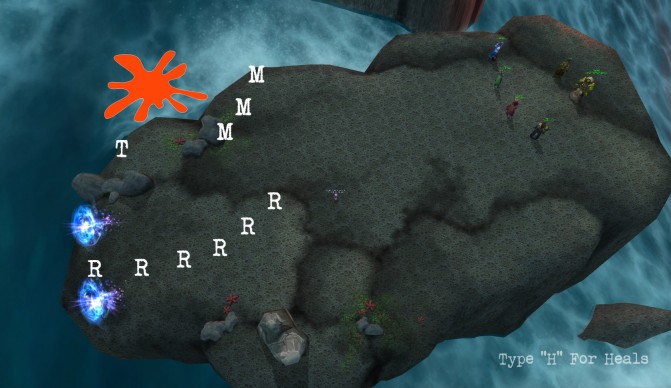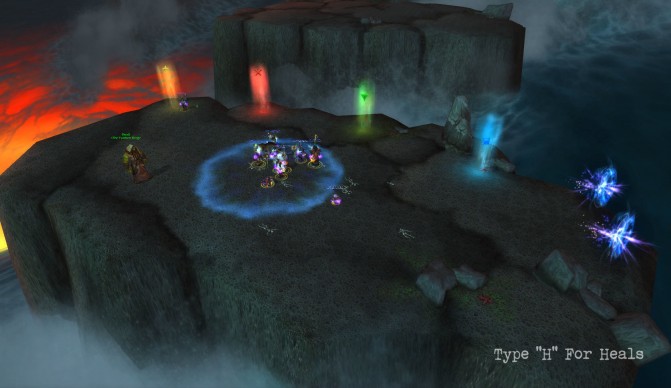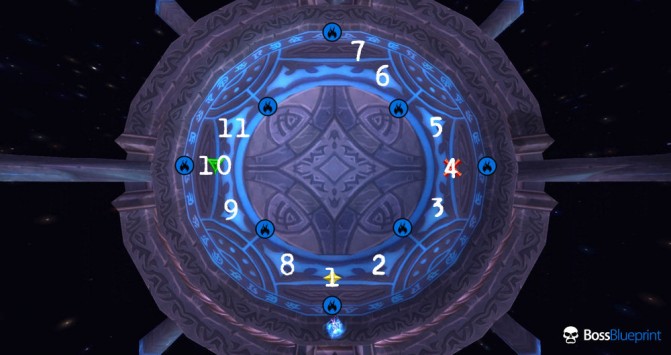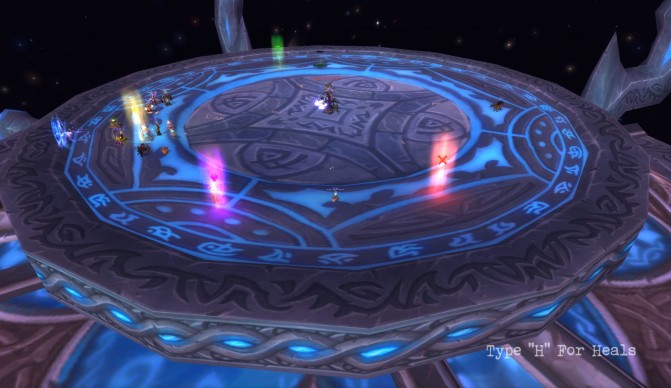
Now that heroic Dragon Soul is over with I find myself in an interesting position: this is the first time in my WoW career that I’ve completed an end boss on heroic while it’s been current content. It’s been a fascinating experience, and I’d like to talk a little about how heroic raiding and healing has felt to me. Are you sitting comfortably? Then I’ll begin…
Context is King
I’ve been flirting with heroic raiding for the last two expansions, but it took me a while to work my way through the ranks of guilds raiding progressively closer to the cutting edge before finally ending up in a guild that was in the running for the top of the server charts.
WotLK was the first time I managed to join a guild that was running hardmode and heroic content, but we didn’t manage to kill heroic Anub’Arak or heroic Lich King on 25-man, only on 10-man with 25-man gear. Not that I’m not proud of the team I achieved those feats with, we all worked hard for them and they were a great bunch of people to raid with, but I still felt we fell short of what some members of the guild could, and probably should, have achieved in the expansion.
In Cataclysm I only got a couple of heroic bosses down in Tier 11 before rerolling yet again to Oceanic so that was a bit of a washout, and reaching 85 midway through Firelands pretty much put paid to my chances of earning a heroic Ragnaros kill before Dragon Soul (although we did go 6/7H post-nerf after starting the guild only weeks before). So DS with <;Abraxas>; was my big opportunity to really push progression and I’m very grateful for the opportunity and for the victory.
What my previous experience gave me was a sense of what heroic fights entailed mechanically but what I’d missed out on from being late to the heroic party and not raiding heroics relatively early, with less gear and thus at the difficult end of the progression curve was a sense of what those fights require of raiders personally.
Heroics Require Focus
And by this I mean total, full-time concentration. When an encounter is really stretching your team’s limits, when your tank is fractions of a second away from dropping dead and when those green bars just don’t seem to ever want to come up again you absolutely have to pay attention the whole time. Glance at your chat log and someone might end up dead. Fail to spot an enemy spell cast and don’t hit your cooldown in time, someone’s dead. Stand in the fire for a second too long and your HPS will be zero for the rest of the fight.
And it’s not just paying attention, it’s also having to constantly think. There’s so little time that you can spend just mashing the same button and waiting for a big blue DBM warning; instead you’re watching timers or learning to feel the fight so you can be ready for the next big thing to come at you, switching spells and healing targets on the fly, and working out what your fellow healers are doing.
And let me tell you, this gets exhausting. We raid 9½ hours per week spread over three nights which isn’t much by some standards, but we generally raid hard for those hours with quick re-pulls after wipes and as little downtime as possible. By the end of good progression nights I’m quite often completely frazzled and no use to anyone for a while afterwards. That’s not to say I didn’t enjoy myself, but it’s hard work, mentally, and if you can’t keep it up for the duration of the raid then you’re just going to be wasting time by the end.
Heroics Require Motivation
So we’ve established that healing heroics is sometimes hard work and tiring; that inherently means you need to find your motivation.
You can be intrinsically motivated – motivated by your own reasons like killing bosses makes you happy or you have a desire to be the best healer you can be – or extrinsically motivated – motivated by something outside the task, maybe so your raid leader will stop yelling at you, or for bragging rights or a shiny mount – or a combination, and neither is inherently “better” than the other.
Whatever you use, you need to be able to stay motivated because healing heroic raids is not going to be fun all the time. For me, it’s a combination of factors, and they come in and out of play as progression rolls on, for example:
- At a basic level I want to kill bosses because it makes me happy to overcome a challenge I’ve been set, but I’ll admit sometimes I wonder if it’s worth the stress.
- I also keep turning up because my team needs me and I don’t want to deny other people the opportunity to raid and beat encounters. That’s partly intrinsic because I know that turning up is the right thing to do, and also partly extrinsic because I’ll lose my raid spot if I leave people in the lurch.
- I also set myself targets like improving my usage of a certain spell or cooldown, or beating my numbers compared to last week. Those small, measurable, achievable goals keep me coming back even when a boss takes weeks to move past and it’s frustrating as hell.
- And yes, I want to stand around Stormwind showing off the title and mount that are the metaphorical carrots dangled in front of me every tier. Nothing wrong with that as a motivational tool!
I think that a good team community helps a lot with motivation. If you feel loyalty to your raid team you’re more likely to want to come back day after day to help them out even when you’re not personally having much fun, and some healthy competition and banter can provide side-goals to keep you aiming at something.
Heroics Require a Thick Skin
This is probably the thing that I’ve struggled with the most. We don’t have a culture of yelling at people in Vent as a general rule, but I know when I’ve missed a cooldown or got myself killed or got someone else killed. I am my own worst critic and I set myself standards which are probably too high, and I’m very good at beating myself up when I don’t meet them.
At the end of the day, you need to remember that heroic raiding is difficult. You will make mistakes and you will cause wipes, everyone does. And because of that you’ll probably be the target of other people’s frustrations at times and even if you don’t get yelled at immediately or called out publicly you’ll probably feel it anyway.
Heroic raiding requires you to pick yourself up, acknowledge your mistakes (to yourself or to your team or both), learn from them, and move on.
Heroics Require Flexibility
Unlike normal modes, where the tuning is a bit more forgiving, heroic raids require the right composition. Over the years the definition of the “right composition” has been made a little more reasonable than stacking your raid with Shaman and making everyone take up leatherworking, but (pre-nerf, at least) 3-healing Ultraxion on heroic just wasn’t happening. So you need to be able to adapt yourself to the demands of the encounter.
For healers (and tanks too, probably more so than for healers) that often means being competent at a DPS spec or being willing to sit out for a mainspec DPS when there’s not a spot for you. I’ve sat on a few bosses and I’ve even tried DPSing, albeit without much success. Fortunately we have healers in the team who are competent in their offspecs, and they make up for my inadequacies!
I’ll also mention that you will sometimes need to work harder, and it might feel like you’re being asked to “carry” another role. We’ve all been there, when you’re dropping a healer because you’re hitting a berserk timer instead of giving your DPS the kick up the backside (you feel) they really deserve. Maybe it’s not fair to make you work harder, maybe other guilds manage just fine with 3 healers instead of 2, but you have to at least be willing to give it your best shot. Whatever it takes to get the boss down, even if that means going way outside your comfort zone.
Flexibility also means tailoring your spec and glyphs to the encounter you’re currently working on, and that’s something everyone will end up doing to some extent. Every fight is different and you can’t rely on one spec, one glyph setup and one reforge and never change anything for an entire tier. You need to think ahead about the mechanics, and look back at logs, to see where you can improve or what needs to change.
Heroics Require Analysis
Which leads nicely to the last thing on my list: you have to be analytical. Not your raid leader or your healing lead, you! And by “you” I of course mean “everyone”. You need to analyse your own performance, your raid’s performance and your strategy and also be able to communicate your ideas to the team (or at least to your raid leader) clearly and concisely.
Your raid leader will have an idea of the strategy they want to employ; they’ve watched the videos, read the guides, understood the mechanics and come up with a plan. Yet the boss is still defeating you. WTF?! Your raid leader will have questions you need to answer, and they can’t answer them on their own. Questions like:
- Why did you die? – Not “what killed you”, plenty of addons will report the proximate cause of your death, but “why were you able to be killed”. The answer might be that you stood in fire for too long, but was there a reason for that? Was everyone too clumped up? Were you preoccupied by too many things to watch? Is something preventing you from seeing the spell effects? Do we need to call out that mechanic? When your raid leader asks a question like this, pretend they’re really asking “how can we help prevent this from happening again”.
- Why didn’t X get healed? – Maybe X got 2-shot and you couldn’t have healed him up, that’s good information. Perhaps a healer was out of commission (Ice Tombed, maybe) and no one noticed. Maybe someone took an unexpected damage spike and everyone switched off the tank to heal him up. To answer this question well you need to understand your assignment and how it relates to everyone else’s, and bear in mind that those assignments might not be formal, they might just be what the healers expect each other to do.
- Why is your HPS (or DPS) so low? – Bad answer: “I don’t know”. Worse answer: “<;myClass>; sucks on this fight. Better answers should relate to the strategy or mechanics. Is there too much movement? Are you missing buffs? Are you not maximising AoE (or cleave, for DPS) opportunities? Bad timing for cooldowns? You get the picture.
I’ll repeat myself, because I think this is one of the most important things I’d tell a new heroic raider: When your raid leader asks a question about why something happened or didn’t happen, don’t stop at answering the question they asked. Instead pretend they’re really asking “how can we help prevent this from happening again?” and answer that question.
Sometimes you might not get your wish, but if you never ask then how will your raid leader know there’s a problem at all? They’re only one person, playing one role, they’re not omniscient.
Is It Worth It?
Absolutely, one hundred per cent, without a doubt.
But do bear in mind that heroic raiding will not always be fun. In the words of the great Del Preston:
It will not be easy.
You will get tired. You will get blisters. You will get aches and pains.
But you will also get good.












